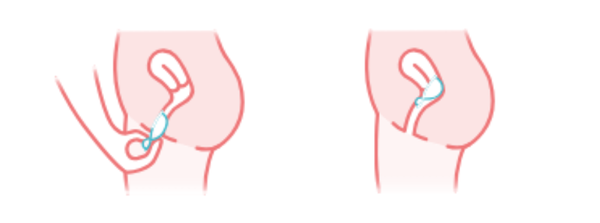Diaphragms or caps are a non-hormonal barrier methods of contraception that protect women against pregnancy by preventing sperm reaching the cervix. Only the neck of the womb (cervix) is covered by this methods, so they do not prevent exposure of the vagina to semen or exposure of the penis vaginal fluids.
Diaphragms/caps are domes made of soft silicone. You can insert them into your vagina before sex to cover the cervix, so that sperm cannot get into the womb. You need to use spermicide with them, as this kills the sperm.
They are useful for women who do not want to use a hormonal or long-lasting contraceptive.
You can book an appointment for contraception at axess here.

With clean hands, put a small amount of spermicide on each side of the diaphragm.
Slide the cap diaphragm into your vagina, so it covers your cervix.
*for perfect use (typical use 88%)
When used consistently, correctly and with spermicide gel, diaphragms and cervical caps are estimated to be about 94% effective at preventing pregnancy.
However, with less-perfect (more typical) use, diaphragms and caps are about 88%. Those using a diaphragm or cap should be advised to use these methods with spermicide gel.
You can purchase a diaphragm and spermicide from pharmacies and your local sexual health clinic.
A diaphragm now comes in one size only, and therefore does not need to be fitted by a health professional. However, you may wish to visit your local sexual health clinic to discuss how you should fit it.
This is rare, but some users find they get a bladder infection, or some irritation from using a diaphragm, or from the spermicide.
A diaphragm does not protect you against STIs, so you may need to use condoms as well.
Those with a vagina who have a sensitivity to latex can use a silicon diaphragm (Kaya) or cervical cap.
However, for those with a history of toxic shock syndrome (TSS), the use of the diaphragm and cervical cap is thought to present more risks than benefits.
Generally, it is not recommended for those who are HIV-positive to use a diaphragm or cap.
The diaphragm or cap should be in date and in good condition.
The spermicide (gel) should also be checked that it is in date.
The gel is held against the neck of the womb (cervix) by the diaphragm or cap and provides a barrier to sperm.
Diaphragms are usually inserted dome-down (some are not).
Approximately two 2 cm strips of spermicide should be placed onto the upper surface of the diaphragm and can be applied to the rim to help, putting it in. If using a cap, the inside of the cap should be filled about a third with gel but none should be put on the rim.
When using lubricant with diaphragms and caps, a water or silicone-based preparation is recommended.
It is not recommended that you use a diaphragm or cap during your period because of a possible risk of toxic shock syndrome.
No, a diaphragm is not a barrier method to prevent STI transmission.
You should put your diaphragm or cap in after a bath, rather than before, because water may dislodge it, or wash away the spermicide gel.
Have a shower rather than a bath during the six hours after you have had sex when you need to keep your diaphragm or cap in. You can go swimming or do water sports.
When you take your diaphragm or cap out, wash it in warm water with a mild, unperfumed soap and rinse.
Dry carefully and keep it in its container in a cool, dry place.
Never:
Do not use any oil-based product with latex types as it will damage them.
Before use, check your diaphragm or cap regularly for tears or holes by holding it up to the light and having a good look at it.
Be careful with your fingernails and jewellery. If your diaphragm goes out of shape, squeeze it gently back into its circular shape. Your diaphragm or cap may become discoloured. But don’t worry, this will not make it less effective.